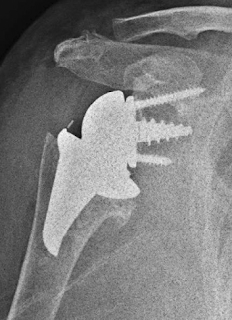These authors report on 102 patients having a reverses total shoulder with a "short metaphyseal reverse total shoulder arthroplasty prosthesis without a diaphyseal stem" which they designed.
98 (20 men, 78 women) were available for follow-up. Mean age was 74.4 years (range, 38-93 years). Indications were cuff tear arthropathy, 65; fracture sequelae, 12; rheumatoid arthritis, 13; failed rotator cuff repair, 3; cuff deficiency with loosening of anatomic prosthesis, 3; and acute trauma, 2; with 17 of these as revisions.
Clinical outcomes were improved. Radiographic analysis showed no lucencies, subsidence, or stress shielding around the humeral or glenoid components. Glenoid notching was found in 21%.
Comment: The authors goal in designing this prosthesis was to preserve humeral bone. It is unclear, however, that their approach is more bone-preserving than an impaction-grafted standard stem as shown below.
We prefer the standard humeral stem with the offset glenosphere shown above because it can manage a wide range of pathologies, some of which (such as that shown below) would be out of reach of a stemless prosthesis.
Our bone preserving reverse total shoulder technique is shown in this post.
Check out the new Shoulder Arthritis Book - click here.
Use the "Search" box to the right to find other topics of interest to you.
You may be interested in some of our most visited web pages including:shoulder arthritis, total shoulder, ream and run, reverse total shoulder, CTA arthroplasty, and rotator cuff surgery as well as the 'ream and run essentials'




